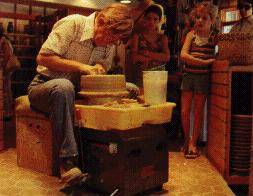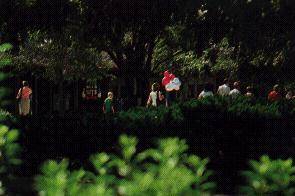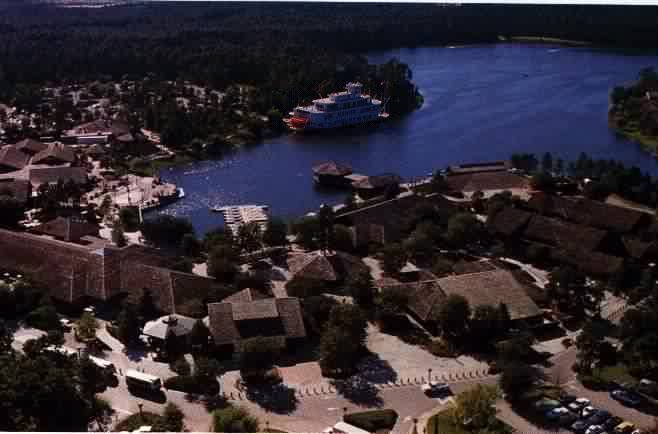

Disney Banner Network

When it opened on March 22, 1975, the Lake Buena Vista
Village was the first official shopping area in Walt Disney World.
Nestled
within the area of the "official hotels", the shopping area became
popular with guests seeking a quiet night, or someplace simply to dine,
still within Disney World, but not in the Magic Kingdom. Eventually
it was renamed the Disney Village Marketplace, up until the area became
known collectively as Downtown Disney, and it became the Downtown Disney
Marketplace.
 The marketplace had its own particular flavor to it,
and as a child I remember that I couldn't wait until the night when we'd
visit the marketplace. One of my favorite places to visit was Mickey's
Character Shop.
The marketplace had its own particular flavor to it,
and as a child I remember that I couldn't wait until the night when we'd
visit the marketplace. One of my favorite places to visit was Mickey's
Character Shop.
 At the Character Shop, they had every imaginable Disney character doll,
as well as a plethora of other things. I remember getting things
like CD's there (official soundtracks), as well as magic tricks.
Actually, following the closing of the Magic Shop on Main Street, they
were the only shop I remember in WDW that continued to sell magic (unless
you count the cart outside the Haunted Mansion).
At the Character Shop, they had every imaginable Disney character doll,
as well as a plethora of other things. I remember getting things
like CD's there (official soundtracks), as well as magic tricks.
Actually, following the closing of the Magic Shop on Main Street, they
were the only shop I remember in WDW that continued to sell magic (unless
you count the cart outside the Haunted Mansion).


 The Marketpalce also featured various craftspeople doing
such things as drawing, or cutting glass. I remember the china shop
they had there, which was close to the Empress Lilly, before it became
part of the entrance of Pleasure Island. But, in addition to that,
there was a shop where people acutually cut, and molded the glass.
I remember them making things like elephants and the like, and for me as
a child I was particularly impressed with the quality, speed, and most
of all, what seemed to be the danger of it all. There were little
wheels that spun very fast, as well as flames from bunsen burners, that
burned extremely hot blue flames. For me as a kid, it was a very
exciting experience to visit the market place.
The Marketpalce also featured various craftspeople doing
such things as drawing, or cutting glass. I remember the china shop
they had there, which was close to the Empress Lilly, before it became
part of the entrance of Pleasure Island. But, in addition to that,
there was a shop where people acutually cut, and molded the glass.
I remember them making things like elephants and the like, and for me as
a child I was particularly impressed with the quality, speed, and most
of all, what seemed to be the danger of it all. There were little
wheels that spun very fast, as well as flames from bunsen burners, that
burned extremely hot blue flames. For me as a kid, it was a very
exciting experience to visit the market place.
 One of the things you'll notice about this shot over
the Marketplace, especially if you're farmiliar with the way the area is
currently situated, you'll notice that Pleasure Island had not yet been
built. As you'll soon see in a picutre below, the entrance to the
park from the Marketplace is right off the side of the Empress Lilly.
One of the things you'll notice about this shot over
the Marketplace, especially if you're farmiliar with the way the area is
currently situated, you'll notice that Pleasure Island had not yet been
built. As you'll soon see in a picutre below, the entrance to the
park from the Marketplace is right off the side of the Empress Lilly.
 Speaking about the Empress Lilly, the story of this
famous ship is perhaps the most tragic of all the changes that have ever
been made over the course of WDW history. The name of the ship came
from Walt Disney's wife, as a tribute to her. Sadly, about a year
or so ago, both the name and the theme of the restaurant were changed,
a sad ending to a lost era of the Disney Village Marketplace.
Speaking about the Empress Lilly, the story of this
famous ship is perhaps the most tragic of all the changes that have ever
been made over the course of WDW history. The name of the ship came
from Walt Disney's wife, as a tribute to her. Sadly, about a year
or so ago, both the name and the theme of the restaurant were changed,
a sad ending to a lost era of the Disney Village Marketplace.

Some of you at this point may say that the Marketplace
is not much different, or any changes that have been made have been made
for the better. I disagree. This page about the Marketplace
is about change, but not about changes to buildings or anything like that.
Its about changes in the way the Marketplace was, the flavor of the Marketplace
from a quiet little shopping village, to a loud and bustling place.
It has lost its quiet, its specialness, and most of all, its innocence.
It is a sad testament to the changes that have been made to WDW.
In order to respond to the increasing demand for
night life at WDW, in 1989 Pleasure Island opened. It was also a
response to Church Street Station, a popular night spot for visitors close
to the city of Orlando. The ticket policy was much the same as Church
Street, one price gets you into all of the clubs in the park. But,
there have been a lot of changes to the Island since it opened.
 Eventually, night time celebrations started popping
up in Pleasure Island at the end of the night (translate as somewhere near
12:00, even thought the park doesn't close usually until 2:00). First
starting with a Mardi Gras theme, then a Conga Line Party, then the park
then began running with their still widely popular New Years Eve theme.
Every night, up to today, continues to be New Years Eve on Pleasure Island.
Eventually, night time celebrations started popping
up in Pleasure Island at the end of the night (translate as somewhere near
12:00, even thought the park doesn't close usually until 2:00). First
starting with a Mardi Gras theme, then a Conga Line Party, then the park
then began running with their still widely popular New Years Eve theme.
Every night, up to today, continues to be New Years Eve on Pleasure Island.

 The nighttime celebration was not the only thing to
change at PI, though. When it first opened, The Pleasure Island Jazz
Club did not exist. Rather, in its place was the Merriwether's Food Court.
Recently the Pleasure Island Jazz Club moved, and changed its theme to
coincide with BET. It now sits in the building that formerly housed
the Neon Armadillo,which moved to a newly build building, and chanced its
name to the Wildhorse Saloon (I believe)
The nighttime celebration was not the only thing to
change at PI, though. When it first opened, The Pleasure Island Jazz
Club did not exist. Rather, in its place was the Merriwether's Food Court.
Recently the Pleasure Island Jazz Club moved, and changed its theme to
coincide with BET. It now sits in the building that formerly housed
the Neon Armadillo,which moved to a newly build building, and chanced its
name to the Wildhorse Saloon (I believe)
 One of my favorite clubs in WDW though is the Rock and
Roll Beach Club, which I continue to this day to call the XZFR Rockin'
One of my favorite clubs in WDW though is the Rock and
Roll Beach Club, which I continue to this day to call the XZFR Rockin'
Rollerdome. When it first opened, it was an exclusively an Oldies
club, with a dance floor on the bottom most level, and a rollerskating
circle track on the second floor. Particularly notable about this
club was that you could go there to rollerskate on Saturday and Sundays
during the day (I never did, but I'm sure that it was fun). Sometime
before 1992, though, the Rollerskating was disbanded, and the club became
simply the XYFR Rock and Roll Club, centering on both oldies and modern
rock and roll. Now, as previously mentioned, it is simply the Rock and
Roll Beach Club.
The building that houses 8-Trax has also seen a
lot of action. Fans of Disneyland will recognize the name Videopolis,
from the stage they have near Tomorrowland, where entertainment occurs
daily. When this club opened it was originally called Videopolis
East. Then it closed down for a short time, and reopened without
changing any of its music or decorations, simply changing its name to the
Cage. The building became 8-Trax around 1994, and continues to play
its disco music until this day.
 One of the most little known features of Pleasure Island
is its original theme story. The following is from the 1990 edition
of Birnbaum's Guide to WDW. "Imagineers tell us that right beside
the Empress Lilly and the Disney Village Marketplace, an island was recently
unearthed where an enterprising, larger than life 19th century ship merchant,
one Merriweather Adam Pleasure held court. Though the merchant sailing
trade was in a decline at the time of his residence, the upsurge of leisure
yachting assured the success of Pleasure's Canvas&Sailmaking, Inc.
The booming business spawned Pleasure Island, a community developed to
abet Mr. Pleasure's pursuit of adventure and excitement...According to
local legend Pleasure turned his entire operation over to his sons while
he circumnavigated the globe, but he was lost at sea in 1939. Pleasure
Island soon fell into disrepair due to the neglect of his lazy offspring.
Enter Disney Imagineers".....So the Legend Continues.
One of the most little known features of Pleasure Island
is its original theme story. The following is from the 1990 edition
of Birnbaum's Guide to WDW. "Imagineers tell us that right beside
the Empress Lilly and the Disney Village Marketplace, an island was recently
unearthed where an enterprising, larger than life 19th century ship merchant,
one Merriweather Adam Pleasure held court. Though the merchant sailing
trade was in a decline at the time of his residence, the upsurge of leisure
yachting assured the success of Pleasure's Canvas&Sailmaking, Inc.
The booming business spawned Pleasure Island, a community developed to
abet Mr. Pleasure's pursuit of adventure and excitement...According to
local legend Pleasure turned his entire operation over to his sons while
he circumnavigated the globe, but he was lost at sea in 1939. Pleasure
Island soon fell into disrepair due to the neglect of his lazy offspring.
Enter Disney Imagineers".....So the Legend Continues.















